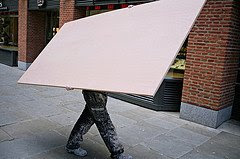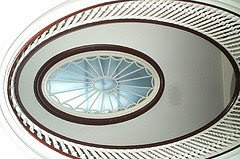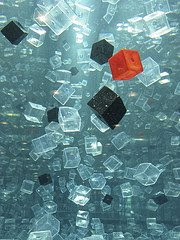Say the geometrical shape you see in the photos on the right hand side. Then describe the object using the adjective form of the noun for the shape. For example, in photo 3 there is a triangle made by the space created by sliced kiwi fruit. The space is triangular, or there is a triangular space.
1.
2.
3. There is a triangle. The space is triangular. There's a triangular space.
4.
5.
6.
7.
8.
9.
10.
11.
12.
13.
14.
Giving instructions
Work in groups of two. Your teacher will give of you an envelope containing lego. Open the envelope and verify that you have the same number and type of lego blocks as your partner. Now sit back to back. One of you make a model using all the lego blocks you have. When you have finished your model your task is to explain to you partner, without looking at them, how to build it. When you have finished, change roles and repeat the exercise.
Use sequencers such as firstly, secondly....finally, and the imperative form of the verb, that is the infinitive without 'to'.
Firstly, take the green block
Then, pick up....
After that, attach...
Having placed the yellow block, now place the blue block.
Now,...
Finally, ....
Discussion
- Were you successful in building your partner's model?
- Why didn't it work?Why did it work? What was difficult in this exercise?
- Sophie receives another anonymous letter. It says, "Why is Lego the greatest toy in the world?" She contemplates this. A day later another anonymous letter arrives, this time a large brown envelope with her lesson from the mysterious philosophy teacher and an answer to the question about Lego. Before you begin examining this text and doing the exercises give your ideas on the greatness or otherwise of this toy.
Reading
In the following extract from Sophie's World the topic sentence from some of the paragraphs have been taken out, their order muddled up and placed below. Your task is to put them back where they belong. Notice that each topic sentence has a letter in front of it. When the missing sentence are placed in the correct order they spell a word. What is it?
THE ATOM THEORY
Here I am again, Sophie. Today you are going to hear about the last of the great natural philosophers. His name is Democritus (c.460-370 B.C.) and he was from a little town of Abdera on the northern Aegean coast. If you were able to answer the question about Lego blocks without difficulty, you should have no problem understanding what this philosopher's project was.
M) Democritus agreed with his predecessors that transformations in nature could not be due to the fact that anything actually "changed"*. He therefore assumed that everything was built up of tiny invisible blocks, each of which was eternal and immutable. Democritus called these smallest units atoms.
…………………………………………………………………... For Democritus it was all-important to establish that the constituent parts that everything else was composed of could not to be divided indefinitely into smaller parts. If this were possible, they could not be used as blocks. If atoms could eternally be broken down into ever smaller parts, nature would begin to dissolve like constantly diluted soup.
t) Moreover, nature's blocks had to be eternal - because nothing can come from nothing. In this, he agreed with Parmenides and the Eleatics. Also, he believed that all atoms were firm and solid. But they could not all be the same. If all atoms were identical, there would still be no satisfactory explanation of how they could combine to form everything from poppies and olive trees to goatskin and human hair.
…………………………………………………………………………………………………………. Some were round and smooth, others were irregular and jagged. And precisely because they were so different they could join together into all kinds of different bodies. But however infinite they might be in number and shape, they were all eternal, immutable, and indivisible.
R) When a body - a tree or an animal, for instance - died and disintegrated, the atoms dispersed and could be used again in new bodies. Atoms moved around in space, but because they had "hooks" and "barbs" they could join together to form all things we see around us.
………………………………………………………………………………………………………………… They have more or less the same properties which Democritus ascribed to atoms. And that is what makes them so much fun to build with. They are first and foremost indivisible. Then they have different shapes and sizes. They are solid and impermeable. They also have "hooks" and "barbs" ** so that they can be connected to form every conceivable figure. These connections can later be broken again so that new figures can be constructed from the same blocks.
A) The fact that they can be used over and over is what has made Lego so popular. Each single Lego block can be part of a truck one day part of a castle the day after. We could say that Lego blocks are eternal. Children of today can play with the same blocks their parents played with when they were little.
………………………………………………………………………………………………………………… These tiny pieces pieces can never be joined together to make something else.
I) Today we can establish that Democritus' atom theory was more or less correct. Nature really is built up of different "atoms" that join and separate again. A hydrogen atom in a cell at the end of my nose was once part of an elephants trunk. A carbon atom in my cardiac muscle was once in the tail of a dinosaur.
…………………………………………………………………………………………………………………… We call these elemental particles protons, neutrons and electrons. These will possibly some day be broken into even lesser particles. But physicists agree that somewhere along the line there has to be a limit. There has to be a "minimal part" of which nature consists.
T) Democritus did not have access to modern electronic apparatus. His only proper equipment was his mind. But reason left him no real choice. Once it is accepted that nothing can change, that nothing can come out of nothing , and that nothing can ever change, and that nothing is ever lost, then nature must consist of infinitesimal blocks that can join and separate again.Adapted from Sophie’s World pp 43 – 45
TOPIC SENTENCES
S) In our time, however, scientists have discovered that atoms can be broken down into smaller "elemental particles."
L) We can form things out of clay too, but clay cannot be used over and over, because it cannot be broken up into smaller and smaller pieces
a) The word "a-toms" means "un-cuttable".
E) Democritus believed that nature consisted of an unlimited number and variety of atoms.
i) So now you see what I mean about Lego blocks.
Answers
References
(JG) Gaarder, Jostein (1994) Sophie's World. Berkley Signature Edition. New York.
Notes
*The natural philosophers and change
Think about a forest fire. The forest is reduced to ashes but over time recovers only to catch fire again and to recover. Has anything really changed? If it has changed what has remained the same and what is different? These are the kinds of questions that ancient Greek philosophers contemplated.
The opening passages of this chapter explain that the Greeks believed that the universe came from something, and this something had always existed. Fundamentally, they believed that there must be a basic substance from which everything was derived and to which everything returned. They were more concerned about how things changed, rather than the origin of this basic substance.
There was considerable debate about whether the changes we observed were actually happening at all, as it was argued that our senses could be deceptive. It was argued that if change was actually occurring, some parts of the process remained constant
The heart of the debate appears to be to what extent are things changing and to what extent are they remaining the same. For Parmenides when you add up all the so-called observable changes they come to one; that is, there is no overall change, the quantity of the basic substance is the same. So change is something of an illusion.
For others this was going too far and didn’t explain what we observe. Empedocles thought everything was composed of differing amounts of the four basic elements of earth, water, air and fire. When something like a flower died for instance it disintegrated into its basic elements.
What also concerned Empedocles was how things were built up from these four elements and how they broke down. He considered it was due to the fundamental forces of love and strife. Love brought things together and strife drove them apart.
** How lego works - "hooks and barbs"
Jostein Gaarder says that Lego bricks or blocks have hooks and barbs. Well, that is sort of true. Lego blocks stick together through a system known as the "stud-and-tube coupling system". The way it works is like this. On the top of the blocks are little round bumps called studs. If you flip the block over you will see one or more tubes or cylinders. When you stick two blocks together you push the studs into the spaces between the walls of the block and the tubes. Because the studs are a little larger than the spaces into which they go, the tubes are squashed slightly. However, because the plastic they are made out of is resilient, they try to return to their original shape, and in doing so they attach. This could be thought of as the "hook". The system is enhanced by resistance or friction between stud and tube which fastens the blocks together. This is called the interference fit and could be thought of as the "barb" of the "hook".
Notice that in order to explain Democritus' atom theory Gaarder uses an analogy of lego which in turn requires an analogy of hooks and barbs to be further explained.














No comments:
Post a Comment